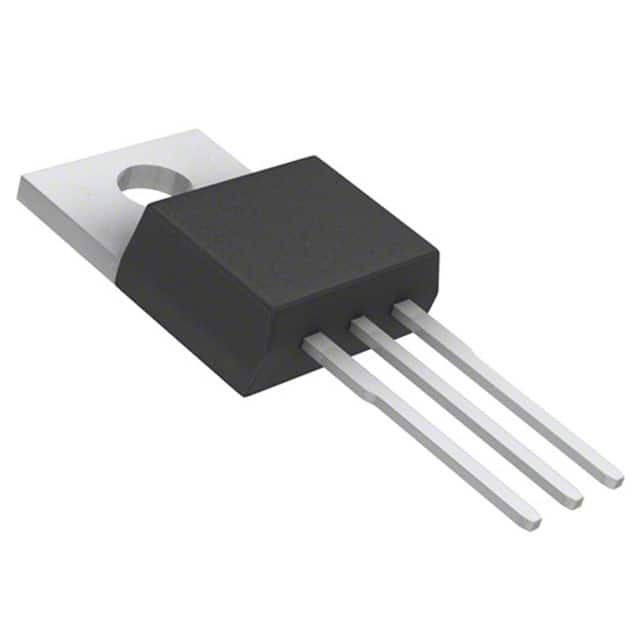Lihat spesifikasi untuk detail produk.

TIP32 Transistor: Encyclopedia Entry
Introduction
The TIP32 is a versatile and widely used transistor that belongs to the category of power transistors. This entry provides an overview of the TIP32, including its basic information, specifications, pin configuration, functional features, advantages and disadvantages, working principles, application field plans, and alternative models.
Basic Information Overview
- Category: Power Transistor
- Use: Amplification and switching applications
- Characteristics: High voltage capability, high current capability, low saturation voltage
- Package: TO-220
- Essence: NPN silicon epitaxial-base planar transistor
- Packaging/Quantity: Typically available in packs of 10 or 25 units
Specifications
- Collector-Emitter Voltage (VCEO): 40V
- Collector-Base Voltage (VCBO): 40V
- Emitter-Base Voltage (VEBO): 5V
- Collector Current (IC): 3A
- Power Dissipation (PD): 40W
- Transition Frequency (fT): 3 MHz
- Operating Temperature Range: -65°C to 150°C
Detailed Pin Configuration
- Base (B)
- Collector (C)
- Emitter (E)
Functional Features
- High voltage capability suitable for various power applications
- High current capability enables it to handle heavy loads
- Low saturation voltage reduces power dissipation and improves efficiency
Advantages and Disadvantages
Advantages
- Versatile and widely compatible with different circuit designs
- Robust construction ensures reliability in demanding environments
- Low saturation voltage enhances energy efficiency
Disadvantages
- Relatively higher cost compared to standard small-signal transistors
- Larger physical size due to the TO-220 package
Working Principles
The TIP32 operates as an NPN transistor, where the flow of current is controlled by the application of a small input current at the base terminal. This controls the larger current flow between the collector and emitter terminals, allowing for amplification or switching functions.
Detailed Application Field Plans
The TIP32 finds extensive use in various applications, including: - Audio amplifiers - Power supply circuits - Motor control circuits - LED drivers - Switching regulators
Detailed and Complete Alternative Models
Some alternative models to the TIP32 include: - TIP31 - TIP41 - TIP122 - 2N3055
In conclusion, the TIP32 transistor offers high voltage and current capabilities, making it suitable for a wide range of power applications. Its robust design and versatile functionality make it a popular choice in the electronics industry.
Word count: 366
Sebutkan 10 pertanyaan dan jawaban umum terkait penerapan TIP32 dalam solusi teknis
What is the TIP32 transistor used for?
- The TIP32 is a PNP bipolar junction transistor commonly used for amplification and switching applications in electronic circuits.
What are the typical operating conditions for the TIP32 transistor?
- The TIP32 transistor typically operates with a collector-emitter voltage (Vce) of around 40V, a collector current (Ic) of up to 3A, and a power dissipation (Pd) of around 40W.
How do I connect the TIP32 in a common emitter configuration?
- In a common emitter configuration, the TIP32's emitter is grounded, the base is biased through a resistor, and the collector is connected to the load.
Can the TIP32 be used for audio amplifier applications?
- Yes, the TIP32 can be used in audio amplifier circuits due to its high current and power capabilities.
What are the key considerations for heat dissipation when using the TIP32?
- Heat sink selection and proper thermal management are crucial when using the TIP32, especially in high-power applications, to ensure the transistor operates within its safe temperature limits.
How does the TIP32 compare to other transistors like the TIP31 or TIP41?
- The TIP32 is similar to the TIP31 but with different polarity (PNP vs. NPN), and it has lower power dissipation compared to the TIP41.
What are the typical applications of the TIP32 in technical solutions?
- The TIP32 is commonly used in audio amplifiers, voltage regulators, motor control circuits, and general purpose switching applications.
What are the maximum ratings for the TIP32 transistor?
- The maximum ratings for the TIP32 include a collector-emitter voltage (Vce) of 40V, a collector current (Ic) of 3A, and a power dissipation (Pd) of 40W.
How do I protect the TIP32 from overcurrent and overvoltage conditions?
- Using appropriate current-limiting and overvoltage protection circuits, such as fuses and clamping diodes, can help protect the TIP32 from damage in adverse conditions.
What are some common failure modes of the TIP32 transistor?
- Common failure modes of the TIP32 include thermal runaway due to inadequate heat dissipation, overcurrent leading to saturation, and voltage spikes causing breakdown. Regular testing and proper circuit design can help mitigate these risks.

